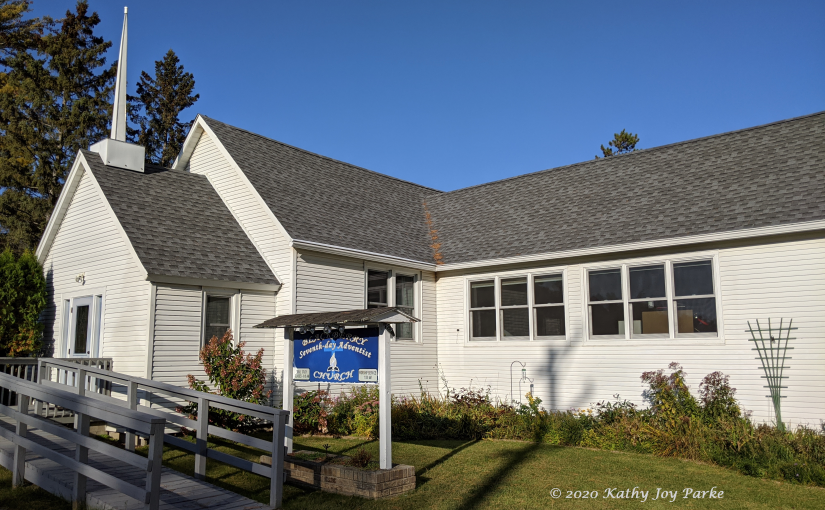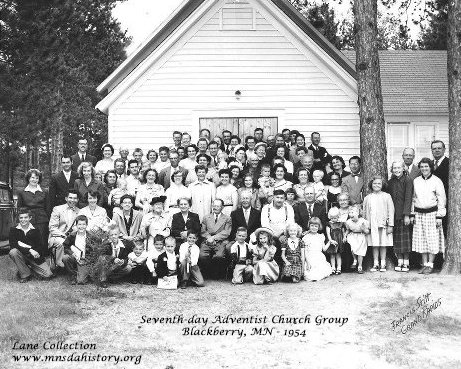Organized: Feeley Township – October, 1908; Blackberry – 1912
Also Known As: Feeley (Warba is located in Feeley Township)
Current Location: 25321 Dove Lane, Grand Rapids, MN Map
Website: https://blackberrymn.adventistchurch.org/
Contributors: Feeley History – Complied by Kathy Parke, Editor
Blackberry History – Compiled by Brent Lane for 2012 Church Centennial
FEELEY – Prelude to Blackberry SDA Church
Organization of Feeley Church (Warba is located in Feeley Township)
Feeley – There are several families of Seventh-day Adventists located in the country round about Feeley. I have visited each of these families and have held a number of meetings with them. As a result of this work I have recently been permitted to organize a company of eleven members with a leader, clerk, treasurer and missionary secretary. There are others living near here who will unite with this company later.
The enemy of all righteousness has been endeavoring to continue his evil work in this place, with the result that hearts have been divided and families separated. Although Jesus has testified that he is a liar, some well-meaning people still give credence to what he says, and are in a continued state of perplexity. As Satan knows that his time is short he is working with great power, and many persons are being deluded by the sophistries presented by his agencies.
Now is the time for each soul to sense its own needs, and to make straight paths, lest that which is lame be turned out of the way. May we all keep this in remembrance. Here is the patience of the saints.
Andrew Mead – Northern Union Reaper, October 27, 1908, 7.
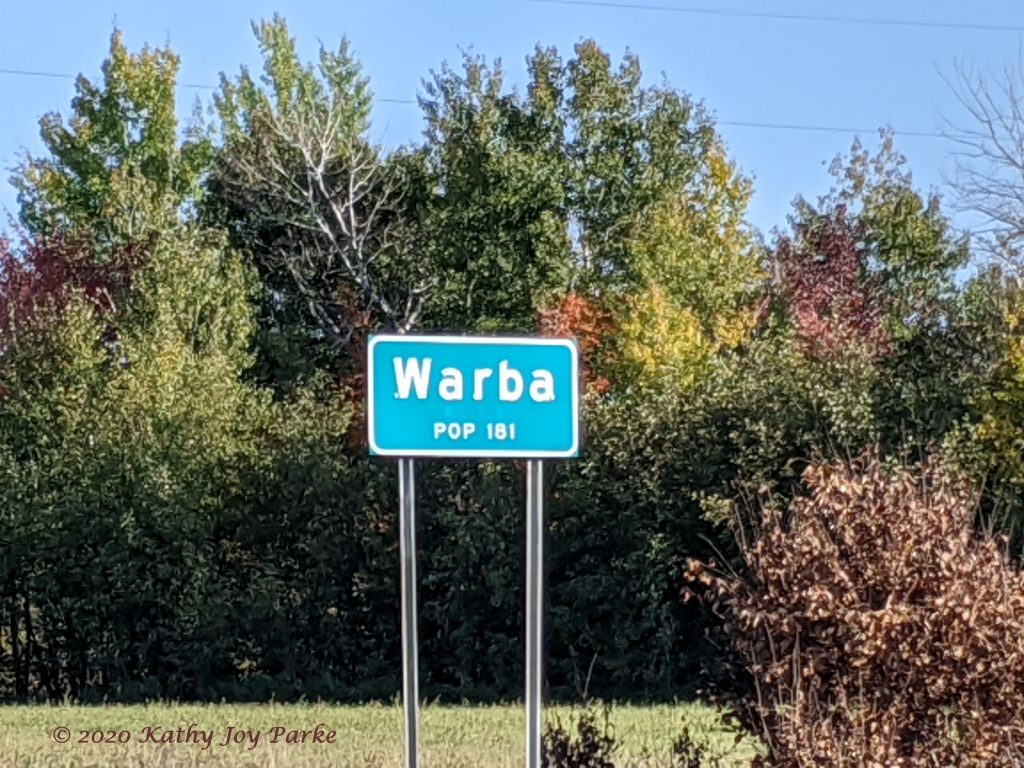
Photo: © 2020 Kathy Joy Parke
Feeley – The Lord has blessed the work in this place since the church was organized last October. I came here about the first of January, and have held some meetings and have visited with the brethren in their homes. Difficulties that had hindered the work have all been settled. The Sabbath school has increased in membership and there is a good interest.
The annual business meeting was held, and officers were chosen for church and Sabbath school. The communion service was held, and eight persons united with the church. Five of these were young people. There are others who should unite with the believers and press on in the Master’s service, faithfully supporting the work at home and abroad. I praise the Lord for what he has done for us at this place. This week I am holding a few meetings near Swan river.
Andrew Mead – Northern Union Reaper, February 2, 1909, 5.
BLACKBERRY HISTORY
Founding History 1902-1912
Compiled by Brent Lane for 2012 Church Centennial
The walls went up in 1912. But that was not the beginning. Churches are neither seeded nor birthed with rock foundations, white clapboard siding, and shingled roofs. The genesis of a church comes in the longing of souls clamoring after Christ, seeking community, seeking encouragement, seeking a structure whereby to populate a city on a hill, a light to the world.
The walls went up in 1912, but the cornerstone was laid two thousand years ago. The psalmist tells us in chapter 127 that, “Unless the Lord builds the house, its builders labor in vain.” It’s just as that old hymn reminds us, “The church has one foundation, it’s Jesus Christ our Lord.”
The walls went up in 1912, but let’s begin the story a decade earlier. In 1902, Fred Bliss brought his family to Blackberry. At that time Blackberry was a small, yet growing community due to its location near the river and railroad. Bliss had become a Seventh-day Adventist only two years earlier, and found himself as the only Adventist in the Blackberry and Grand Rapids area.
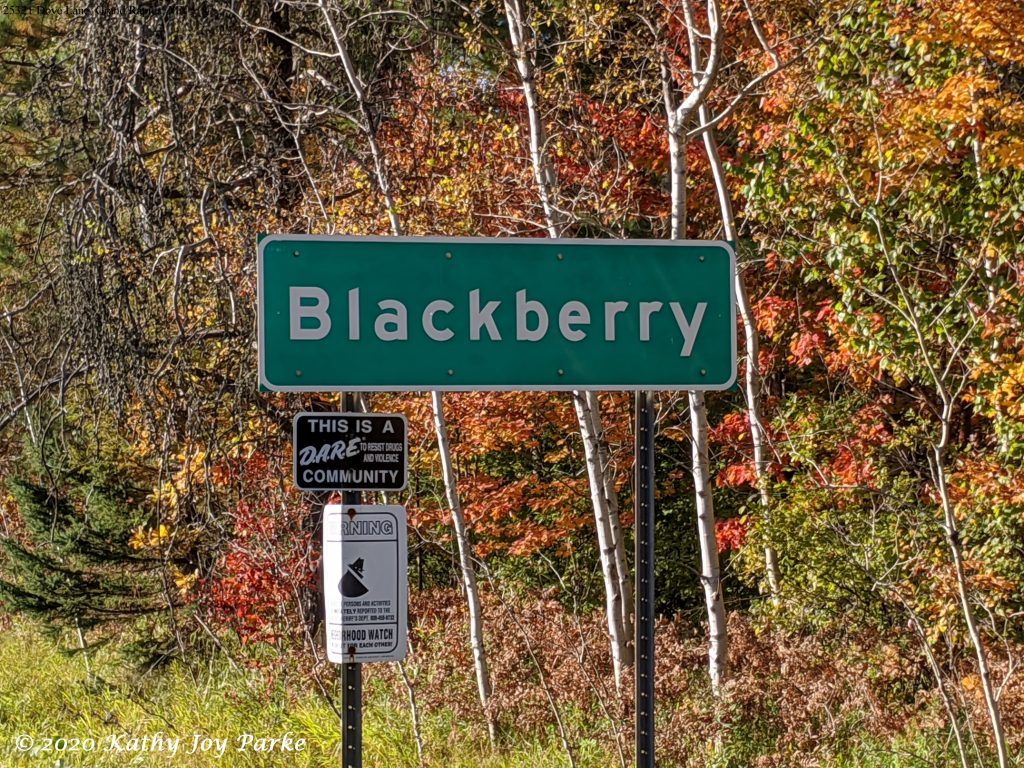
Photo: © 2020 Kathy Joy Parke
There was a healthy community of Adventists seven miles to the east at Feeley (later known as Warba). The Pogue family led a strong little group of worshipers in that area. Not only were the Pogues groundbreakers in northern Minnesota, they also spread the gospel in far and distant mission fields.
Had it been 2012, Bliss would have happily gotten in his car and driven the short distance to join the Feeley group. However, this was before the automobile and Highway 2. Trains did run between the villages, but historical records don’t indicate the frequency nor schedule, which may not have been consistent with worship services. Added to this was the fact that the Feeley church often met several miles north of town, either at the Pogue’s home or a nearby schoolhouse. In short, at that time there was no reliable or easy transportation between Blackberry and Feeley, making consistent fellowship for Bliss and his family difficult.
In addition to this, Bliss was also eager to see the Adventist message grow in his own community. In 1907 Bliss requested a Swedish evangelist from the Northern Union. Fred Johnson arrived to hold meetings at the public school building in Blackberry. (For those interested in geography, that school building sat near the current Hazelwood cemetery, just northeast of the railroad tracks – the building itself is now part of the North Central Antique Tractor Association show grounds just across the street from the church. It is in the process of restoration.)
Some might view those first meetings as a failure. Only one family seemed convicted and they didn’t become baptized until 1908. However, it is significant to note that the one family baptized as a result of those first meetings was the Axel Anderson family – a family who became a cornerstone of strength to this young congregation.
Other seeds, too, had been sown by those meetings. Over the next five years those seeds were nurtured and a healthy Sabbath School developed in Blackberry.
The Blackberry Sabbath School became part of the Feeley church, which had organized in 1908. In Blackberry, homes were used for regular weekly worship. The two groups would come together on a quarterly basis when conference ministers visited the region.
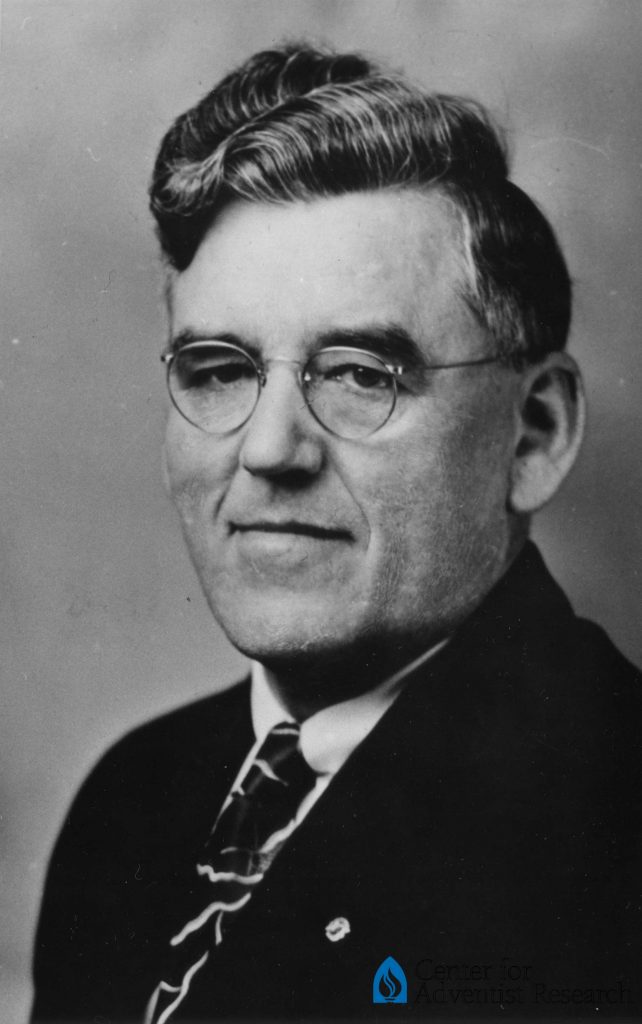
Photo: Center for Adventist Research
In addition, evangelistic meetings took place once, sometimes twice a year between 1908 and 1911, culminating with a series presented by Soren Ruskjer in the fall of 1911.
In the Northern Union Reaper of September 26, 1911, Ruskjer reports that “Last Sunday about one hundred thirty persons gathered on the shore of the beautiful Mississippi river while eleven dear souls were buried with their dear Saviour in the watery grave by baptism.”
Among this group was the greater part of another family of Andersons, the Charles G. Anderson family, whose later service to the young congregation was also significant. So the number of worshipers in the area continued to grow.
Significant to the establishment of a church in Blackberry is an event recorded in the June 18, 1912 Minnesota Conference committee report: “Whereas, Many members of the Feeley church have moved away from that location, and a church building is being built at Blackberry, We recommend that the name of the Feeley church be changed to the Blackberry church, as they have petitioned.”
The Blackberry church was born, though really not much had changed. There were thirty members in the church when it was organized, many of them Andersons. Fred Bliss and his family were also charter members. Added to this were some still from the Warba group: names like Dahl, Reed, Bluntach, and Pogue. William Pogue, in fact, continued to serve as a leader – he was the first elder of the Blackberry group, and served in that capacity for some time. The pulpit that is still used in the church today was built by his hands and it was very likely built for the opening of the new church.
The church structure under construction in that conference report was finished sometime in the fall of 1912. The lot had been donated by a non-Adventist community member. With other donations of certain materials and labor, cash expended on the building was something less than $175. The original structure, according to a December 8, 1912 Reaper article, was “20×30 feet in size, well lighted, and comfortably seated with chairs, and in every way representative of the message of truth. At a conservative estimate the building is valued at $1000.”
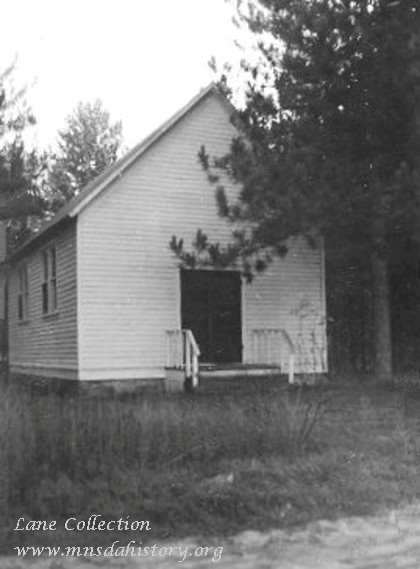
Photo: Douglas and Sula Lane Collection
The church was dedicated on the weekend of November 29-December 1, 1912. Conference President G.W. Wells reported this in the Northern Union Reaper:
“We reached Blackberry in good season Friday, and were met at the station by Brethren Pogue and Anderson. The first meeting in the newly erected church was held that night. Elder Thompson spoke from the text found in 2 Peter 1:16, reviewing the chief points in prophecy and showing us that we were not following cunningly devised fables in teaching and living this Advent Message.
On Sabbath day the time was filled in and God came very near His people. The morning hour was occupied by the writer and the spirit of humility and contrition was manifested. Nearly every soul present responded to the call for renewed consecration.
The afternoon service was an hour of real refreshing. After Elder Thompson spent a few moments in recounting the mercies of God we had a social meeting and it was evident that God’s spirit was present. One feature which was a source of much satisfaction was the part taken by the young people in this service.
Sunday the building was dedicated. The morning hour was used in giving instruction to our people along the line of organization and the importance of our great world-wide message. The dedicatory service was held at 2 p.m. Brother Pogue, the elder of the church, first gave us a brief history of the church, the date of its organization, its growth, and what led up to the plan to build. He told in an interesting manner how material was gathered for the building, and the interest taken on the part of all to see the work pushed forward to completion….
The dedicatory address was delivered by Elder Thompson and the prayer offered by the writer. As there was no encumbrance on the building, a thank offering was taken up at the close of the exercises for missions. The brethren feel very grateful for this monument for the truth, and were greatly encouraged by the meetings held.
The closing service, Sunday night, was somewhat lengthy. As we did not take our departure until the midnight train, most of the people desired to remain, so the time was fully occupied with the study of the scriptures, singing, and prayer. We took our departure, feeling that the Lord had been with us all, and that each one had received a blessing.”
The Early Years 1913-1939
The membership at Blackberry did not sit around following the building and dedication of the church. For one, they had been heavily engaged in outreach during the founding years, and this lifestyle carried on naturally into the next decade. Reaper articles bring attention to some of the activities.
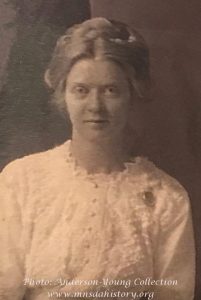
Lynn Anderson-Young
Frances Anderson spent part of 1913 engaged in the Swedish work in St. Paul, returning home again to Blackberry for the winter. In 1914, Mrs. Axel Anderson and Florence Warner contemplated starting on a missionary trip selling the Temperance Instructor and Signs monthly on the Iron Range. Subsequent reports show earnings of $140 in a two week period, and later we read that Warner planned to attend Broadview Seminary in Illinois, using her canvassing income to help fund that education. (Broadview was the Swedish seminary) Katie Pogue left to become a teacher at the Adventist church school in Minneapolis, but visited Blackberry in the spring of 1913 in the interest of the church school work.
Elder B.C Haak visited Blackberry for a week of prayer in December of 1913. The members met at 4:00 each afternoon for the prayer meeting, with a preaching service each night. “Some of them walked nearly 6 miles to the services and were at every meeting and never late,” Haak recorded in the Reaper, adding, “I don’t believe I have ever experienced a week of prayer in which all felt the nearness of God’s spirit and such earnest seeking after God as we did during the last week of prayer.”
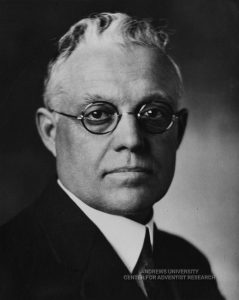
Photo:
Andrews University
Center for
Adventist Research
Evangelistic efforts continued strong during these early years, another baptism occurring on May 16, 1914, in Shallow Lake at the home of Charles G. Anderson. Five people were baptized that day, and Elder G. W. Wells, who officiated that day recalled, “The descent into the lake was gradual, the water was clear, and the lake had a white sandy bottom. There was a holy joy that filled the hearts of the candidates and a blessed quietness settled down on all who attended. It was a very impressive service and I believe each one present felt the Divine influence. Standing on the bank of that beautiful lake, as the service was closing and we sang the last song, the desire was expressed by several, that the entire company might, in the near future, stand together on that sea of glass before the throne of God.”
The clerk’s notes from the quarterly meetings of this era reveal several things. One interesting issue involved the deed for the church. The lot had been donated by a community member. When in 1916 the conference requested a deed, they rejected the one passed along by the church because the land donor had included a reversion clause: if the church no longer met for a period of at least a year, the land would go back to the donor. This was not satisfactory to conference officials. After several notations on this issue over several quarters, the members in Blackberry determined to ask the donor for an absolute deed with no reversion clause. Absent that, they determined to ask for the opportunity to purchase the lot or permission to move the church. A later note states that a letter had been sent on the matter, but no reply had been received. Strangely, it is the last mention of the issue in the notes, with no resolution shared.

Another noteworthy and frequent occurrence in the clerk’s notes involves non-attending members. Much discussion and prayer were given to those in the church who were no longer attending. Members were sent to visit and encourage these folks, and to inquire what their reasons might be for their absenteeism. In some cases, issues of health or transportation or family conflict were revealed. Some shared their desire to reaffirm and strengthen their faith and conviction. Others revealed that they no longer believed parts of the church’s message to be truth.
Eventually some of these names were removed from membership, but the notes reveal a deliberate and prayerful approach to those missing members, the church in some cases laboring with visits and such for a period of years before any decisions were made.
It’s also of note that while the Feeley church merged into the Blackberry church in 1912, by no means did the strong group of Adventists disappear completely from that area. Through the teens and on into the ‘20s, a group of the Blackberry church continued to meet regularly at Warba, even having their own church officers and presenting their own financial reports at the quarterly meetings.
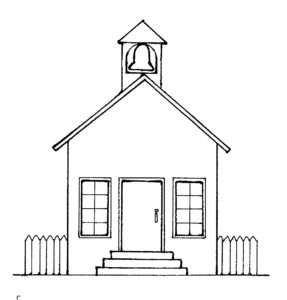
At one point only a few years after the church was built in Blackberry, notes indicate that members voted to meet for the winter at Sandy Lake Schoolhouse in Warba, the residents of Blackberry agreeing to travel there. In December of 1925 we find record of a vote to meet permanently at the church in Blackberry with only one set of officers. By this time, unlike the early years, a good road connected the two villages, and no doubt the ease of transportation contributed to the decision.
As the ‘20s got underway, some interesting notes appear in the Reaper from Elder H.L. Wood, the conference minister assigned to this area of the state at that time. He found that at Bovey a nice Sabbath School had been organized. Over the next decade occasional reference is made to this group, which at one time reaches the size of 16.
On November 15, 1921, Wood also visited several believers in International Falls. “Following this,” records Wood, “I walked about 8 miles through the woods up the Big Fork River and found Brother George Waugh who is opening up a little farm. He too was glad to see an acquaintance and believer.”
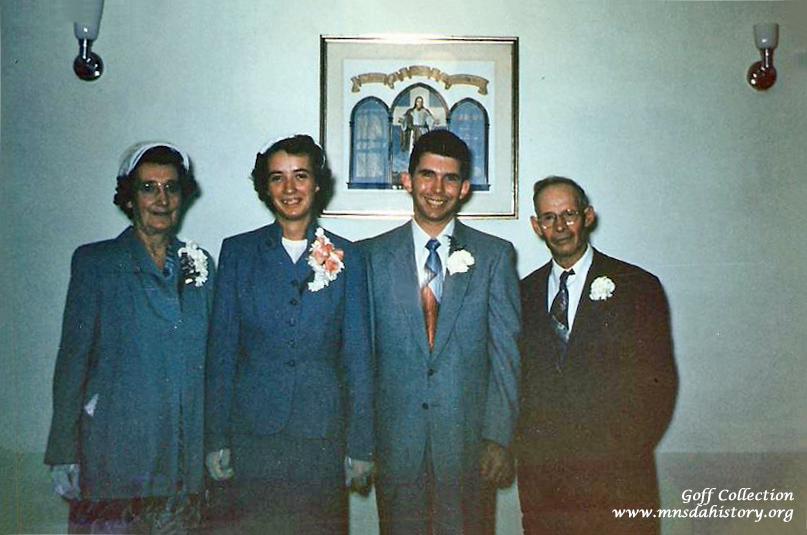
Ilura Waugh, Juanita (Waugh) Goff,
Bill Goff, George Waugh
Photo: Goff Family
Waugh later moved closer to the Blackberry area, and he and his wife became members in Blackberry in 1927. His daughter Juanita was able to enjoy the church’s centennial celebration in 2012 and has been a lifelong member of the Blackberry church.
By the mid-‘20s, Elder C.W. Rubendall had taken charge of the district, visiting at least quarterly and encouraging and instructing the members in Harvest Ingathering campaigns, investment programs, and evangelistic series.
As the 1930’s rolled around, Elder Pontynen had charge of the district, and investment projects were flourishing. A Reaper report from the Range shared some of the local projects: George Waugh, eggs laid on Sabbath; Mrs. George Waugh, a portion of her flowers; Edith Sandstrom, hens; Mrs. A.A. Reid, $1 wages per week when working; Mrs. Marilla Pressnal, a portion of ground set apart for produce, among others.
Not only did the ingathering and investment projects receive much attention in Reaper (and by 1932, Outlook) articles, but locally they were obviously taken quite seriously. By the mid-‘30s, we find that a Sabbath School was initiated in Grand Rapids, which eventually gained company status. Blackberry members who helped lead out in this effort included names like Hallsted, Waugh, and Mundy.
The 1940’s-1950’s
Members continued to take Investment projects quite seriously as the next decade rolled around. In 1940, statewide Sabbath School Investment honor banners went to Hutchinson, Blackberry, and Spring Valley, each church being tops in its membership group.
In 1942 the conference instituted a new district organization plan. The Outlook lists these groups in District 11 under the leadership of A.J. Lockert: Blackberry, Hibbing, International Falls, Remer, Virginia, Chisholm S.S., Deer River Branch S.S., Grand Rapids Company, and Littlefork Company.
Also serving this district in the 1940’s were C.R. Lickey and Adrian Woods. A major expansion project took place in 1948 when the school addition became a reality. This included the school room just south of the sanctuary, as well as a basement.
By 1950 Ruben Widmer had arrived. He remained until 1954, overseeing the Iron Range district. In an Outlook report from December 1952, Widmer writes that, “In spite of the plague of army worms last summer which covered most of the district and left the trees entirely stripped of leaves, and the long steel strike which closed every iron mine, we thank the Lord that He has blessed His people here both materially and spiritually.”
He goes on to note a 50% increase in tithe in the district that year, 25 members baptized, plus about 10 families who had joined the church, many of whom were from the Remer settlement when the church there closed.
Blackberry’s membership numbers support the essence of that report. Conference reports show a church membership of 35 during the 3rd quarter of 1950. By the 3rd quarter of 1952 that number was at 76, and thoughts of further expansion were discussed. However, the only addition to occur in the decade was when the entryway was added onto the sanctuary.
When Widmer left in 1954, Vernon Emmerson became the district pastor, assisted one year by Jerry Coyle, who was also the church school teacher in Blackberry. Also during this time frame, Blackberry members reached out to the community of Deer River, where small groups of believers had worshiped on and off through the years. Specifically, Drs. Gerald Buchanan and James Nakamura re-organized a Sabbath School in that town, where both men worked.
By 1956 it was even recorded that a church building was under construction at Deer River, the walls and roof had been completed with windows and doors soon to follow. This was however, the last mention in the Outlook of that group in Deer River.
The 1960’s-1970’s
The 1960’s brought Helton Fisher, Lewis Anderson, and Wesley Brown as pastors. By 1962, a major remodeling project occurred. For one thing, new pews were installed to brighten the sanctuary. An addition was also completed along the east side providing room for the rostrum, as well as additional Sabbath School rooms. Also significant were the bathrooms, meaning no more cold, wintry trips to the outhouse in the back.
Outlook reports from this time indicate the emphasis placed upon children at the Blackberry church – from numerous Vacation Bible School programs, to a series of Voice of Youth meetings presented by the youth of the Blackberry M.V. department, to highlights from the Blackberry church school.
Pastor Thearon Staddon replaced Pastor Brown, and he remained at Blackberry until 1975. After he left, Wilbur Chapman agreed to pastor in the district. Pastor Chapman had most recently served as pastor at College View in Lincoln, NE, but health problems had caused him to step down. He came to Blackberry with his wife, Alpha (Lane), who had several siblings here. By the time of the pastoral opening, his health had improved, and he served here for the better part of a decade.
In the 1970’s the church was active in the Arrowhead Dorcas Federation (Myvon Polensky is pictured in the Outlook as president of that organization for a period). The church also, for the first time, provided outreach at the Itasca County Fair, as well as presenting Five Day Stop Smoking clinics and Vacation Bible School programs.
In 1979 a new Pathfinder club was formed at Blackberry. Nicknamed the Gems, it was led by Cathy Peterson and Bill Colwell. Attendance at this time was strong. Just as the 1950’s was witness to a steady increase in attendance, as the 1970’s progressed attendance once again rose to a nearly full house.
1980s-today
Outlook reports from 1980 show a variety of activities in the Blackberry congregation. Investment projects for that year were quite creative, relying on the natural resources of the area: raising calves, pledging an amount for every wild species photographed, and one member pledged a certain amount for each walleye caught.
One unique outreach activity, headed by Steve Reiners, was an offer placed in the Itasca Shopper for free copies of “Bible Readings for the Home.” Over one hundred responses were received, and to each respondent was hand-delivered a copy of the book.
In the fall of 1981 a Sabbath School was again started in Grand Rapids. This Sabbath School soon gained church status, and the congregation remains there today. This new venture reduced attendance in Blackberry, but provided another avenue for the gospel to be spread in the northland.
By this time, the district included Grand Rapids, Hibbing, Virginia, and Blackberry—still a good sized district for a pastor but a far cry from the early days. However, expectations change as well. Instead of pastoral coverage only once or twice a quarter, the norm became two Sabbaths a month at each church.
Pastor Chapman retired permanently in 1985, moving soon after that to Pipestone near his daughter’s home. Ironically, Pipestone is where the next pastor arrived from, as Paul Barcenas and his family served Blackberry from December of 1985 until 1990.
The 1990’s brought Robert Knaubert, Robert Miller, and Homer Trecartin to the district as pastors. As was the case throughout the century, each one added his unique strengths and personality to the ministry. Mary Jo Wimmer noted in her Blackberry church reflections that she still remembers the sermon that Pastor Knaubert preached that convicted her and Greg of the Sabbath – such memories being reminiscent of those old Reaper stories from the early days, and proof that the Holy Spirit continues to draw hearts and minds to the Bible.
Outreach emphases of the 1980’s-90’s included booths at the Itasca County Fair, often with a health emphasis, Five Day Plans, Vacation Bible Schools, cooking schools, and several evangelism seminars. Another unique outreach, in correlation with the school, was the Adopt-a-Grandparent program. Elderly neighbors in the Blackberry area were each “adopted” by a young person. On Sabbath afternoons the young people would drive around the neighborhood as a group, dropping off cards and crafts to each one. At the end of the year, the students would be revealed to the “grandparents”.
A new century has brought further changes to the Blackberry congregation. By the time the 1990’s were past, the Virginia church had closed, and redistricting had brought the Northome church into the district family. Pastor Trecartin left for the seminary in 2002, at which time Bob Forbes served for four years.
Pastor Forbes had an interesting connection to Blackberry, as it was his mother, Vergie Steiner, who was the first teacher when the church school opened in 1949. Pastor Forbes served at Blackberry until 2006, and he was followed by the current pastor, Ron Booth, who arrived in 2007.
Pastor Booth had been a member in Blackberry for parts of the previous thirty years, spending several stints in the mission field in addition to years as a stone mason and teacher. His was, perhaps, an unusual journey into pastoral ministry, but one that fits.
This decade brought a resurgence of children to the Sabbath School rooms, with several large, young families. As such, Vacation Bible School continued to be an important outreach during much of these years. The church was also active for a time volunteering at Grace House, the homeless shelter in Grand Rapids.
In more recent years, Blackberry put time and resources into facilitating the Itasca chapter of CHIP (Complete Health Improvement Program) as well as the Depression Recovery Program. Both led to numerous meaningful contacts in the community.
As the church entered its second century, starting in the fall of 2013, with funds provided by a generous donor, another remodeling project was completed. The entire school and annex areas were remodeled with an addition creating space for a fellowship room, a kitchen, and new bathrooms and classrooms. This project was completed early in 2014, and the congregation prays that the space will serve the local community for years to come.
But that’s simply a structural addition. More important is what happens in the hearts of those who worship at Blackberry, and how they are led to impact the community. “Unless the Lord builds the house, its builders labor in vain,” we read in Psalms. As Blackberry moves forward into a new century, the prayer is to continue to meet the needs of the community by fulfilling their mission statement of “Demonstrating love, sharing truth.”
No doubt the men and women who founded the Blackberry church would be surprised that we are still on earth today with the centennial reunion of the Blackberry church having taken it’s place in history too. By God’s grace, though, the next reunion will not take place here where moth and rust destroy. By God’s grace, the next reunion will take place on the sea of glass next to the throne of God. You can be there! As will be Fred Bliss along with dozens of Andersons and Pogues, some Sandstroms and Waughs, along with many others whose journey with Christ included some time in Blackberry. Today we stand on the shoulders of giants. Today we honor them, but more importantly, we honor the God who draws us all with an everlasting loving kindness.
